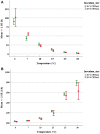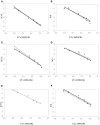Determination of Temperature Dependent Growth Parameters in Psychrotrophic Pathogen Bacteria and Tentative Use of Mean Kinetic Temperature for the Microbiological Control of Food
- PMID: 30568650
- PMCID: PMC6290036
- DOI: 10.3389/fmicb.2018.03023
Determination of Temperature Dependent Growth Parameters in Psychrotrophic Pathogen Bacteria and Tentative Use of Mean Kinetic Temperature for the Microbiological Control of Food
Abstract
Temperature is the main factor to control the microbial growth in perishable foods. The psychrotrophic pathogen bacteria are microorganisms of concern for food products with extended shelf life in chilling conditions. The aims of this work were two. Firstly, to evaluate growth behavior of Aeromonas hydrophila DSM-30187, Listeria monocytogenes DSM-20600, and Yersinia enterocolitica DSM-27689 strains, at different temperatures (4, 7, 10, 15, 25, and 30°C) and starting cell concentrations (10 and 106 CFU/mL), in order to determine the activation energies (E a) of the relevant lag phases and growth rates. Secondly, to investigate if Mean Kinetic Temperature (MKT) might be applied in recording temperature devices to alert a thermal abuse in a management control system for food safety. As expected, lag phase and growth rate proved to be heavily affected by temperature whereas the inoculum size did not. The E a values involved in the duration of latent periods, calculated on the basis of the Arrhenius model, were comparable for A. hydrophila and L. monocytogenes strains (from 21.3 to 24.4 kcal/mol), while significantly differed for Y. enterocolitica (16.6 kcal/mol). The E a values of growth rates were similar for A. hydrophila and L. monocytogenes strains (from 20.9 to 21.1 kcal/mol), while were considerably lower for Y. enterocolitica (from 14.2 to 16.7 kcal/mol). The use of MKT is widespread and well-accepted in pharmaceutical field as convenient method for estimating drugs degradation in relation to storage temperature. The E a value of the lag phase found for L. monocytogenes (23.9 ± 1.2 kcal/mol) was included in the MKT formula. In this work, the air temperature of two chilling rooms was monitored during the normal operating activity in a catering company for a period of 8 months. The MKT profiles were then compared with those of mean temperatures in different conditions (short or prolonged events of thermal abuse) with the purpose to evaluate if it may be applicable to reduce false alarms without lowering the safety level of stored food.
Keywords: Aeromonas hydrophila; Ea values; Listeria monocytogenes; Yersinia enterocolitica; food safety; growth parameters; mean kinetic temperature.
Figures





Similar articles
-
A phenomenological model to infer the microbial growth: A case study for psychrotrophic pathogenic bacteria.J Appl Microbiol. 2022 Jan;132(1):642-653. doi: 10.1111/jam.15215. Epub 2021 Jul 26. J Appl Microbiol. 2022. PMID: 34260802
-
Growth of Listeria monocytogenes, Aeromonas hydrophila and Yersinia enterocolitica in pâté and a comparison with predictive models.Int J Food Microbiol. 1993 Oct;20(1):1-11. doi: 10.1016/0168-1605(93)90055-l. Int J Food Microbiol. 1993. PMID: 8251302
-
Inactivation of Escherichia coli, Listeria monocytogenes and Yersinia enterocolitica in fermented sausages during maturation/storage.Int J Food Microbiol. 2009 Jan 31;129(1):59-67. doi: 10.1016/j.ijfoodmicro.2008.11.011. Epub 2008 Nov 17. Int J Food Microbiol. 2009. PMID: 19064299
-
Thermal and biological treatments to control psychrotrophic pathogens.Poult Sci. 1996 Sep;75(9):1126-32. doi: 10.3382/ps.0751126. Poult Sci. 1996. PMID: 8878273 Review.
-
Achieving continuous improvement in reductions in foodborne listeriosis--a risk-based approach.J Food Prot. 2005 Sep;68(9):1932-94. doi: 10.4315/0362-028x-68.9.1932. J Food Prot. 2005. PMID: 16161698 Review.
Cited by
-
The Impact of Fluid Flow on Microbial Growth and Distribution in Food Processing Systems.Foods. 2025 Jan 26;14(3):401. doi: 10.3390/foods14030401. Foods. 2025. PMID: 39941998 Free PMC article. Review.
-
A New Approach in Meat Bio-Preservation through the Incorporation of a Heteropolysaccharide Isolated from Lobularia maritima L.Foods. 2022 Dec 6;11(23):3935. doi: 10.3390/foods11233935. Foods. 2022. PMID: 36496743 Free PMC article.
-
Microfluidic Based Whole-Cell Biosensors for Simultaneously On-Site Monitoring of Multiple Environmental Contaminants.Front Bioeng Biotechnol. 2021 Mar 9;9:622108. doi: 10.3389/fbioe.2021.622108. eCollection 2021. Front Bioeng Biotechnol. 2021. PMID: 33791284 Free PMC article.
-
Probing efficient microbial CO2 utilisation through metabolic and process modelling.Microb Biotechnol. 2024 Feb;17(2):e14414. doi: 10.1111/1751-7915.14414. Microb Biotechnol. 2024. PMID: 38380934 Free PMC article.
-
Enhanced production of extracellular L-asparaginase in batch culture via nitrous acid-induced mutagenesis of Aspergillus oryzae.Microb Cell Fact. 2025 Jul 25;24(1):172. doi: 10.1186/s12934-025-02797-8. Microb Cell Fact. 2025. PMID: 40713580 Free PMC article.
References
-
- Adams M. R., Moss M. O. (2008). The microbiology of food preservation,, in Food Microbiology, 3rd Edn., eds Adams M. R., Moss M. O. (Cambridge: RSC Publishing; ), 92–97.
-
- Adley C. C., Dillon C. (2011). Listeriosis, salmonellosis and verocytotoxigenic Escherichia coli: significance and contamination in processed meats,, in Processed Meats: Improving Safety, Nutrition and Quality, ed Kerry J. P. (Cambridge: Woodhead Publishing Lim; ) 72–108.
-
- Anderson G., Scott M. (1991). Determination of product shelf life and activation energy for five drugs of abuse. Clin. Chem. 37, 398–402. - PubMed
LinkOut - more resources
Full Text Sources
Molecular Biology Databases
Research Materials

